-- From the border to Palmer
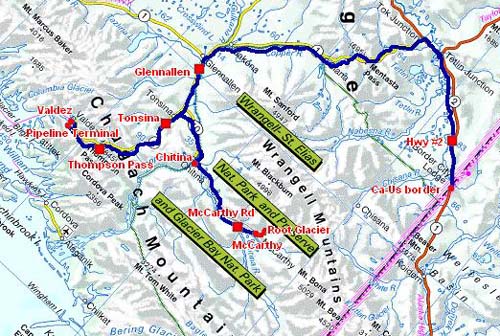
The road tracklog
from the border to Palmer
from 2011/06/14 to 2011/06/19
The travelog of the three days in Yukon, Canada is here
Enter Alaska again
Of course no check at Canada border, but at USA border to enter again Alaska the control was effective but symbolic because the officer checked that my passport was already recorded and the visa obtained at Skagway validated, duration 5 minutes. I carried on my road to find a bivouac at 17 km further away. But I had omitted to delay my clocks of one hour, I stopped too early.
Consequently the following day was a long driving day on Alaska Hwy # 1, then Tok Cutoff and finally Glenn Hwy # 2. They had a carriageway surfacing sometimes very degraded or under repair and decorated with flowers on edge… At the lunch pause I observed a bird pecking the bark of a tree.

Flowered Hwy
Tok Cutoff
Hwy #1
15/06/2011

Woodpecker?
Tok Cutoff Hwy #1
15/06/2011
At the crossroads in Glennallen a Us Army convoy of vehicles filled up tanks with fuel. I benefited from it to see the tires. The fuel vehicle is equipped with Michelin 16.00R20XZL and trucks with Michelin 395R20XML.

Us Army
Glennallen
15/06/2011
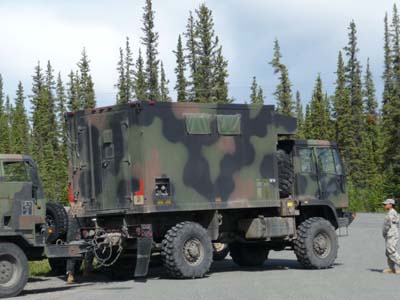
Us Army
Glennallen
15/06/2011
I bivouacked at the edge of the Copper River where I saw on the opposite bank a Bald Eagle looking at me with its sharp eye.

Bald Eagle
Copper River
15/06/2011
On the move to Valdez I visited in the early morning the Historic Copper Center along the Old Richardson Hwy. It was miserable, more or less dilapidated houses, old carcasses of abandoned cars. Admittedly some houses were restored. It is not Switzerland with its manicured gardens .

Copper Center Roadhouse
Historic Copper Center
16/06/2011

Museum
Historic Copper Center
16/06/2011
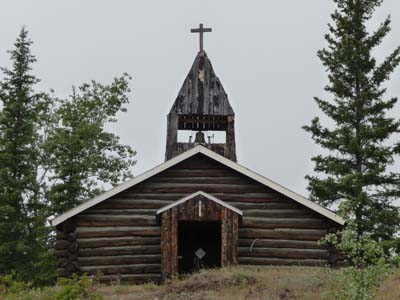
Chapel on the Hill
Historic Copper Center
16/06/2011
Further away I was diverted by Edgerton Hwy # 10 to see Chitina -a Ghost Town- then by McCarthy Road to visit Kennecott Mines. I gave up this last part after Copper River Bridge, weather was very cloudy with a persistent drizzle making the narrow gravel road muddy and slippery, it is built on the rail bed of the old railroad from McCarthy to Cordova transporting copper ore. I returned to Chitina to heat me with an American coffee. Copper River is famous for salmon fishing practiced with of Fishwheels.
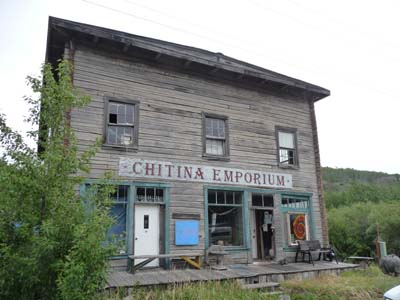
Ghost Town
Chitina
16/06/2011

In 1900's
Chitina
16/06/2011

Ballast railroad
McCarthy Rd
16/06/2011
Back to Richardson Hwy I continued my way to the Thompson Pass where I bivouacked between Worthington Glacier and Twentyseven Mile Glacier at approximately 800 meters high. This rich day in the recent history of Alaska was tarnished by bad weather, cloudy sky covered the snow-capped summits.

Worthington Glacier
Richardson Hwy#4
16/06/2011
I again met Captain James Cook in Valdez, he discovered the site in 1778 and called it Prince William Sound. The site of the city is imposing in this sunny day, certainly a little buckled, mountains with snow-caped summits surround it. The temperature was pleasant. The city suffered two major damages: the first on March 27, 1964 an earthquake magnitude 9.2 follow-up by a tsunami destroyed it and submerged it, it was rebuilt in 1967 4 miles eastwards; the second on March 24, 1989 –Good Friday– the tanker Exxon Valdez ran up against a reef releasing the largest black tide in North America. The city owes its richness with the oil terminal of Trans-Alaska Pipeline 800 miles long from Prudhoe Bay to Valdez and with tourism. Indeed Valdez is the year-round ice-free north most port in the USA. Tourism is also active year round.

Keystone Canyon
Richardson Hwy #4
17/06/2011
The Valdez museum is rich of items of the first settlers as well as gold seekers facing the roughness of the climate to cross the mountains.

Cartoon
Valdez Museum
17/06/2011

Old Valdez
Valdez Museum4
17/06/2011
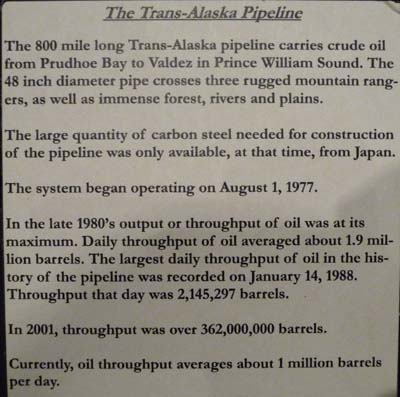
Oil pipeline
Valdez Museum
17/06/2011
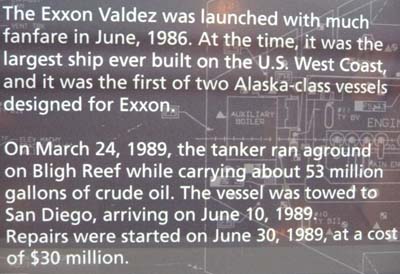
Exxon Valdez
Valdez Museum
17/06/2011

Exxon Valdez
Valdez Museum
17/06/2011
Whitney Museum exhibits collections concerning the First Nations and the wild animal life piled up by Whitneys. I spent the beginning of afternoon at the library offering a Wifi access. Then I took again the road to stop before Tonsina.
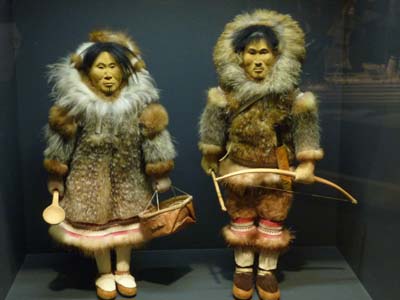
Dolls
Maxime & Jesse Whitney Museum
17/06/2011
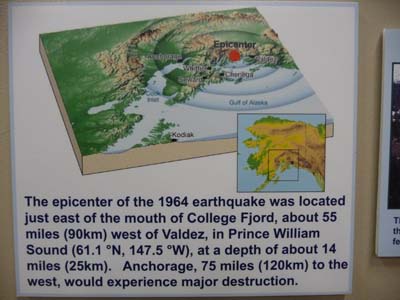
Remembering Old Valdez
Valdez Museum
17/06/2011
At the junction between Richardson Hwy # 4 and Edgerton Hwy # 10 I finally decided to go to see the most famous Alaska industrial waste land, Kennecott Mines, a detour of 300 km return including 200 km of gravel road. Weather was sunny with clouds but nothing worrying. In Chitina I deflated the tires at 2.5 bars, the gravel road is sometimes out of corrugated sheet. Along the 60 miles some historic sights allow to rest roughness of the way at the advised speed of 20 mph. Stop obliged at the paying parking at McCarthy before the pedestrian bridge. The museum of the city recalls the story of the mine with items and especially very eloquent pictures of time for the rigor of the life in winter at -40°C. The historic site is at 8 miles at the bottom of mountains where the mining galleries are Erie, Bonanza and Jumbo which I did not visit. The approach of the site is splendid, red buildings more or less dilapidated with hundred windows. I strolled freely between buildings in the heat sun of Alaska. The copper ore was discovered in 1900, of which content was nuggets at 98%, chalcocite at 70% and malachite at 55%. The financial J.P. Morgan and Guggenheim provided funds for the setting in production of the site. The 196 mile railway from the port of Cordova to McCarthy was built from 1908 to 1911, then vessels transported the ore to Tacoma, Washington; the last train left the site in November 1938.
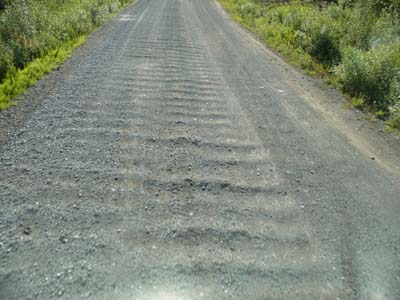
Gravel road
McCarthy Road
18/06/2011

Gilahina Bridge
McCarthy Road
18/06/2011

November 11, 1938
McCarthy Museum
18/06/2011
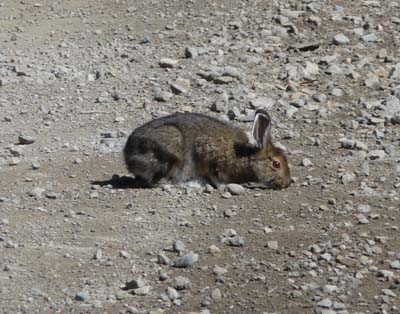
Rabit on the trail
McCarthy Road
18/06/2011

Entrance
Kennecott Mines
18/06/2011

Concentration Mill
Kennecott Mines
18/06/2011

Power Plant
Kennecott Mines
18/06/2011

Landscape
Kennecott Mines
18/06/2011
On Sunday June 19 I returned to Chitina where I took a brunch at the Hotel Chitina by publishing my website. On the move on the gravel road I took some pictures in particular at the Copper River Bridge where Fishwheels were in action. It is said that this technique was imported from China by Chinese miners at the Gold Rush era. Before leaving I re-inflated the tires of my truck. Weather was rainy and cold, In Alaska weather changes very quickly.
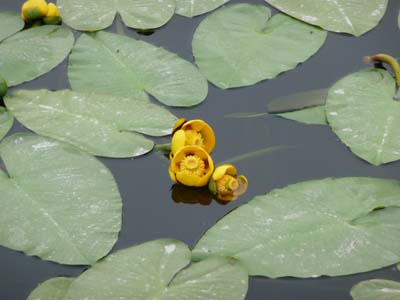
McCarthy Rd
19/06/2011
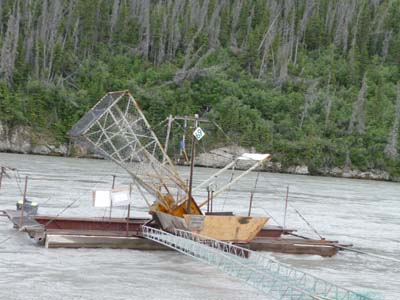
Fishwheel
Copper River Bridge
19/06/2011

Fishwheel
Copper River Bridge
19/06/2011
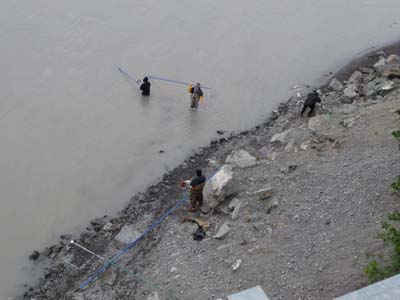
Fishermen
Copper River Bridge
19/06/2011